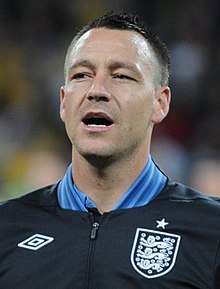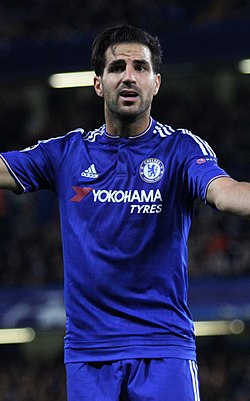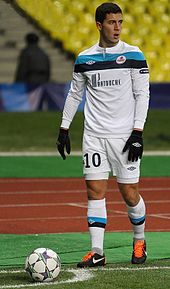One of the most successful clubs in English football, Chelsea had their first major success in 1955, when they won the league championship, and subsequently won various cup competitions between 1965 and 1990. The club have enjoyed their greatest period of success in the past two decades, winning 17 major trophies since 1997.[3] Domestically, Chelsea have won five league titles, seven FA Cups, five League Cups and four FA Community Shields, while in continental competitions they have won one UEFA Champions League, two UEFA Cup Winners' Cups, one UEFA Europa League and one UEFA Super Cup. Chelsea are the only London club to win the UEFA Champions League,[4] and one of four clubs, and the only British club, to have won all three main UEFA club competitions.[5][6]
Chelsea's regular kit colours are royal blue shirts and shorts with white socks. The club's crest has been changed several times in attempts to re-brand the club and modernise its image. The current crest, featuring a ceremonial lion rampant regardant holding a staff, is a modification of the one introduced in the early 1950s.[7] The club have sustained the fifth-highest average all-time attendance in English football.[8] Their average home gate for the 2014–15 season was 41,546, the seventh highest in the Premier League.[9] Since July 2003, Chelsea have been owned by Russian billionaire Roman Abramovich.[10] In May 2015, they were ranked by Forbes magazine as the sixth most valuable football club in the world, at £898 million ($1.37 billion).[1
In 1904, Gus Mears acquired the Stamford Bridge athletics stadium with the aim of turning it into a football ground. An offer to lease it to nearby Fulham was turned down, so Mears opted to found his own club to use the stadium. As there was already a team named Fulham in the borough, the name of the adjacent borough of Chelsea was chosen for the new club; names like Kensington FC, Stamford Bridge FC and London FC were also considered.[12] Chelsea were founded on 10 March 1905 at The Rising Sun pub (now The Butcher's Hook),[1][13] opposite the present-day main entrance to the ground on Fulham Road, and were elected to the Football League shortly afterwards.Chelsea have only had one home ground, Stamford Bridge, where they have played since the team's foundation. It was officially opened on 28 April 1877 and for the first 28 years of its existence it was used almost exclusively by the London Athletic Club as an arena for athletics meetings and not at all for football. In 1904 the ground was acquired by businessman Gus Mears and his brother Joseph, who had also purchased nearby land (formerly a large market garden) with the aim of staging football matches on the now 12.5 acre (51,000 m²) site.[35] Stamford Bridge was designed for the Mears family by the noted football architect Archibald Leitch, who had also designed Ibrox, Celtic Park and Hampden Park.[36] Most football clubs were founded first, and then sought grounds in which to play, but Chelsea were founded for Stamford Bridge.When Stamford Bridge was redeveloped in the Bates era many additional features were added to the complex including two hotels, apartments, bars, restaurants, the Chelsea Megastore, and an interactive visitor attraction called Chelsea World of Sport. The intention was that these facilities would provide extra revenue to support the football side of the business, but they were less successful than hoped and before the Abramovich takeover in 2003 the debt taken on to finance them was a major burden on the club. Soon after the takeover a decision was taken to drop the "Chelsea Village" brand and refocus on Chelsea as a football club. However, the stadium is sometimes still referred to as part of "Chelsea Village" or "The Village".
Crest
1953–1986 Chelsea crest
Chelsea have always worn blue shirts, although they originally used the paler eton blue, which was taken from the racing colours of then club president, Earl Cadogan, and was worn with white shorts and dark blue or black socks.[63] The light blue shirts were replaced by a royal blue version in around 1912.[64] In the 1960s Chelsea manager Tommy Docherty changed the kit again, switching to blue shorts (which have remained ever since) and white socks, believing it made the club's colours more modern and distinctive, since no other major side used that combination; this kit was first worn during the 1964–65 season.[65] Since then Chelsea have always worn white socks with their home kit apart from a short spell from 1985 to 1992, when blue socks were reintroduced.Chelsea are one of the most widely supported football clubs in the world.[70][71] They have the fifth highest average all-time attendance in English football[8] and regularly attract over 40,000 fans to Stamford Bridge; they were the seventh best-supported Premier League team in the 2013–14 season, with an average gate of 41,572.[72] Chelsea's traditional fanbase comes from all over the Greater London area including working-class parts such as Hammersmith and Battersea, wealthier areas like Chelsea and Kensington, and from the home counties. There are also numerous official supporters clubs in the United Kingdom and all over the world.[73] Between 2007 and 2012, Chelsea were ranked fourth worldwide in annual replica kit sales, with an average of 910,000.[
Main articles: West London derby, Arsenal F.C.–Chelsea F.C. rivalry and Chelsea F.C.–Leeds United F.C. rivalry
Chelsea do not have a traditional rivalry on the scale of the Merseyside derby or the north London derby. Matches against fellow West London sides Fulham and Queens Park Rangers
have only taken place intermittently, due to the clubs often being in
separate divisions. A 2004 survey by Planetfootball.com found that
Chelsea fans consider their main rivalries to be with (in order): ArseChelsea's highest appearance-maker is ex-captain Ron Harris, who played in 795 competitive games for the club between 1961 and 1980.[86] The record for a Chelsea goalkeeper is held by Harris's contemporary, Peter Bonetti, who made 729 appearances (1959–79). With 103 caps (101 while at the club), Frank Lampard of England is Chelsea's most capped international player.
Frank Lampard is Chelsea's all-time top goalscorer, with 211 goals in 648 games (2001–2014);[86] he passed Bobby Tambling's longstanding record of 202 in May 2013.[87] Seven other players have also scored over 100 goals for Chelsea: George Hilsdon (1906–12), George Mills (1929–39), Roy Bentley (1948–56), Jimmy Greaves (1957–61), Peter Osgood (1964–74 and 1978–79), Kerry Dixon (1983–92) and Didier Drogba (2004–12 and 2014–2015). Greaves holds the record for the most goals scored in one season (43 in 1960–61).[
Ownership and finances
Chelsea owner Roman Abramovich
Chelsea's kit has been manufactured by Adidas since 2006, which is contracted to supply the club's kit from 2006 to 2018. The partnership was extended in October 2010 in a deal worth £160 million over eight years.[126] This deal was again extended in June 2013 in a deal worth £300 million over another ten years.[127][128] Previously, the kit was manufactured by Umbro (1975–81), Le Coq Sportif (1981–86), The Chelsea Collection (1986–87) and Umbro again (1987–2006). Chelsea's first shirt sponsor was Gulf Air, agreed during the 1983–84 season. The club were then sponsored by Grange Farms, Bai Lin Tea and Simod before a long-term deal was signed with Commodore International in 1989; Amiga, an offshoot of Commodore, also appeared on the shirts. Chelsea were subsequently sponsored by Coors beer (1994–97), Autoglass (1997–2001) and Emirates Airline (2001–05). Samsung Mobile (2005–08) and Samsung (2008–15).[129][130] Chelsea's current shirt sponsor is the Yokohama Rubber Company. Worth £40 million-per-year, the deal is second in English football to Chevrolet's £50 million-per-year sponsorship of Manchester United.[129]In 1930, Chelsea featured in one of the earliest football films, The Great Game.[135] One-time Chelsea centre forward, Jack Cock, who by then was playing for Millwall, was the star of the film and several scenes were shot at Stamford Bridge, including the pitch, the boardroom, and the dressing rooms. It included guest appearances by then-Chelsea players Andrew Wilson, George Mills, and Sam Millington.[136] Owing to the notoriety of the Chelsea Headhunters, a football firm associated with the club, Chelsea have also featured in films about football hooliganism, including 2004's The Football Factory.[137] Chelsea also appear in the Hindi film Jhoom Barabar Jhoom.[138] In April 2011, Montenegrin comedy series Nijesmo mi od juče made an episode in which Chelsea play against FK Sutjeska Nikšić for qualification of the UEFA Champions League.[139]Chelsea also operate a women's football team, Chelsea Ladies. They have been affiliated to the men's team since 2004[149] and are part of the club's Community Development programme. They play their home games at Wheatsheaf Park, the home ground of Conference South club Staines Town.[150] The club were promoted to the Premier Division for the first time in 2005 as Southern Division champions and won the Surrey County Cup in 2003–04, 2006–10, 2012, and 2013.[151] In 2010 Chelsea Ladies were one of the eight founder members of the FA Women's Super League.[152] They were FA WSL runners-up in 2014, their best performance in the competition to date. In 2015, Chelsea Ladies won the FA Women's Cup for the first time, beating Notts County Ladies at Wembley Stadium.[153] John Terry, the current captain of the Chelsea men's team, is the President of Chelsea Ladies.[154]






